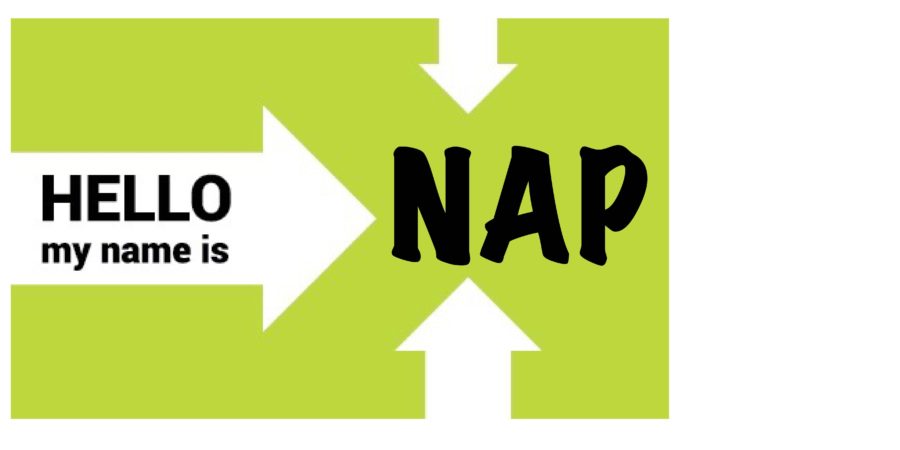What is a NAP (and why does Google’s behavior depend on it?)
NAP is digital marketing’s acronym for a triad of basic information: Name – Address – Phone. Your NAP is used by search engines to verify you have a legitimate, permanent, established place of business and answerable phone.
When it comes to conveying a serious, stable intent to conduct commerce, NAP is one of the primary units of data. To pop up prominently in local SEO, your contact information, your NAP, needs to be absolutely accurate. Ranking high in local organic searches starts with getting your name out, getting people to your location and getting the calls when they come in.
Being correct and consistent with your NAP builds confidence in customers. Reinforce your reputation every time your NAP appears in search results or content writing. Nothing infuriates a person more than ringing a phone number, only to find it’s been disconnected, or driving to an address only to find you’ve moved. So always update NAP immediately and monitor it frequently.
Do You Go By Deb, Debbie, Debra or Deborah?

Obviously your name is important. Whether you inherited Manny’s Automotive from Uncle Manny or labored over the Nothing Bundt Cakes brand with an ad agency, you want it to appear the same way every time your company’s name appears. Not Mannys, not Manny’s Auto, not Manny’s Auto Shop. And for heaven’s sake, never Nothing But Cakes. You paid a lot for that pun!
When Google does its algorithmic abracadabra to determine which local business it pulls out of a hat, it deliberately seeks out and rewards accurate NAP over other factors like backlinks, reviews and social engagement.
Many, if not most, ranking demotions can be attributed to a mismatched NAP. You start to see how important and what a positive effect a proper name, address and phone number has on local SEO. One inconsistency and, presto, you’ll disappear like a rabbit.
Where Should You Take Your NAP?

Here are three places to use NAP prominently on a website:
Page Footer
Many experts believe you should always have your name, address and phone number displayed on every page, preferably in the footer. The thinking is, having read and engaged with an entire page, the last thing a visitor sees is your NAP, imprinting your name for an inbound return.
Contact Page
When people want to check if you’re the Baker Plumbing in Old Town or the Baker Brothers in West Chester, they click on the contact link. This is the most important place for NAP, positioned at the top of your “Contact Us” and “About Us” pages.
Google Map
Once your NAP is fully utilized across your website, consider adding a Google Map to assist local SEO. Just the presence of that graphic adds legitimacy to your physical location, makes it simple for customers to find you and, by proximity, reinforces you’re local. Google Maps will walk you through it. Type in the address, click share and when the Embed Map tab appears with a code, just paste that into your website.
Keep in mind, Google cannot find your NAP when it is part of an image or logo. You need to make it easy to “crawl” with HTML formatted text. Also, don’t use a post office box, corporate address or shared phone number.
A Consistent NAP is Critical

There’s no telling how many versions of your NAP are floating around. Say you used a landline for business last year and your cell phone for business now. Locating, claiming and changing those old citations can be a humongous task and often creates accidental duplicate listings.
In a previous blog, I explained that a citation is anywhere your NAP is mentioned on the Web, intentionally or unintentionally. It could be in one of the business directories like Yelp, Yahoo! Local, Foursquare, MapQuest, Bing Places, Yellowpages or ShowMeLocal. Even if your name, address or phone number appears in your book club’s blog or a Lions Club newsletter, that’s a citation. If it differs from one place to another, Google thinks you’re a flake and may rank you lower.
In order to reel in all the wrong information, get a list of local citations and start searching. You’ll have to test several different ways. Some things to look for are previous business names, prior locations, secondary locations and corporate addresses. Search for old cell numbers, past landlines, call tracking and toll-free numbers. Some sites collect data from many sources, but don’t merge carefully thereby producing duplicates.
To get the most returns, type in just a portion of the business name. For Anna’s Knit Shop just use “Anna’s” to bring up these variations: Anna’s Knitting, Annas (no apostrophe) Knit Shop and Anna’s Knit Shop Lessons.
You can do this with any part of your NAP. Put in just the phone number and see how many versions you were unaware of surface. Or, let’s say your address is 3548 Pinebrook NE, Suite 100. Searching the entire thing only produces pages with an exact match. The portion common to all sites, 3548 Pinebrook, will probably yield more.
Now that you have located all the listings, you can claim them and fix them fairly easily. Not all sites are responsive to outside edits and you may have to let them go. You’ll have done your part to improve local SEO.
For a more in-depth discussion about locating and repairing local citations, give us a call. We take NAPs seriously!





